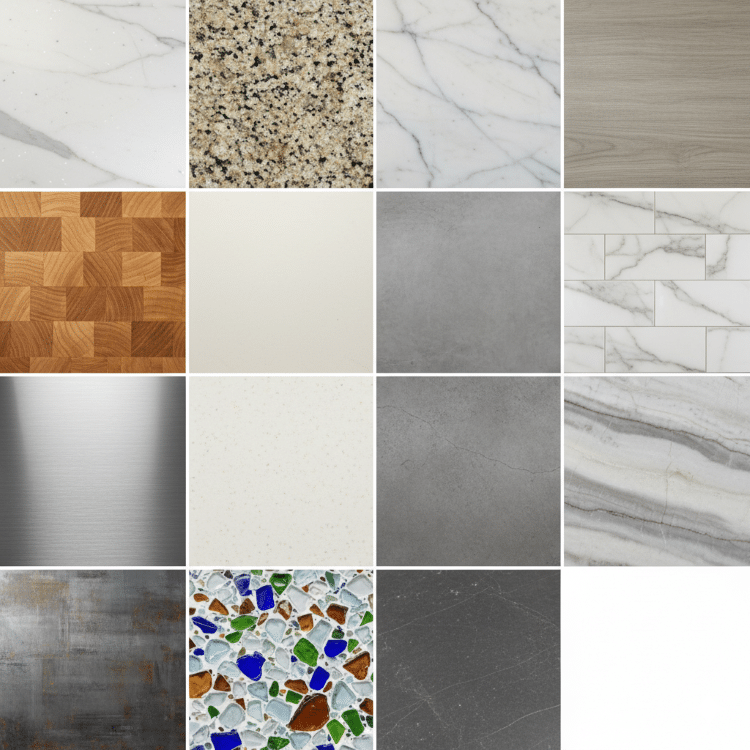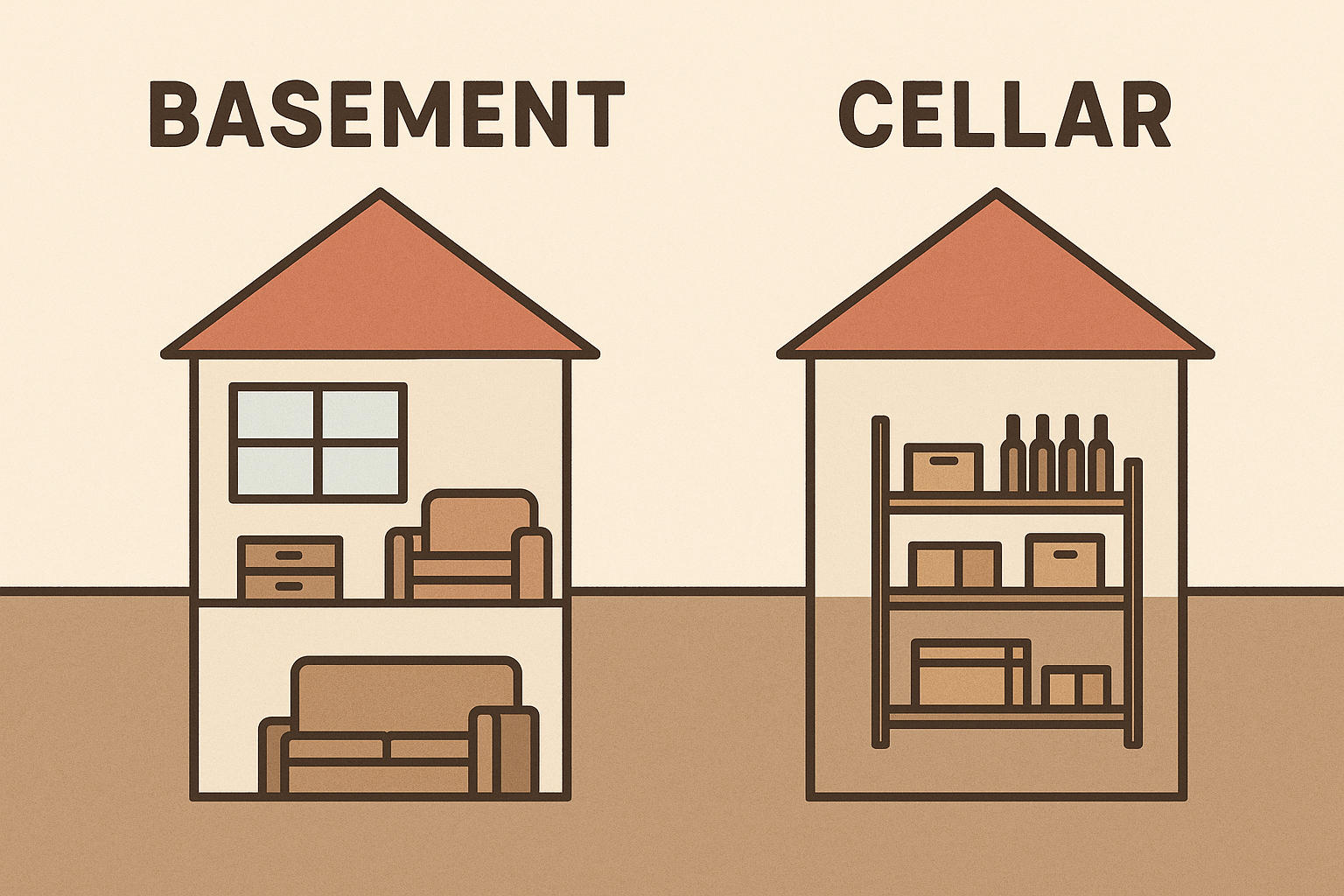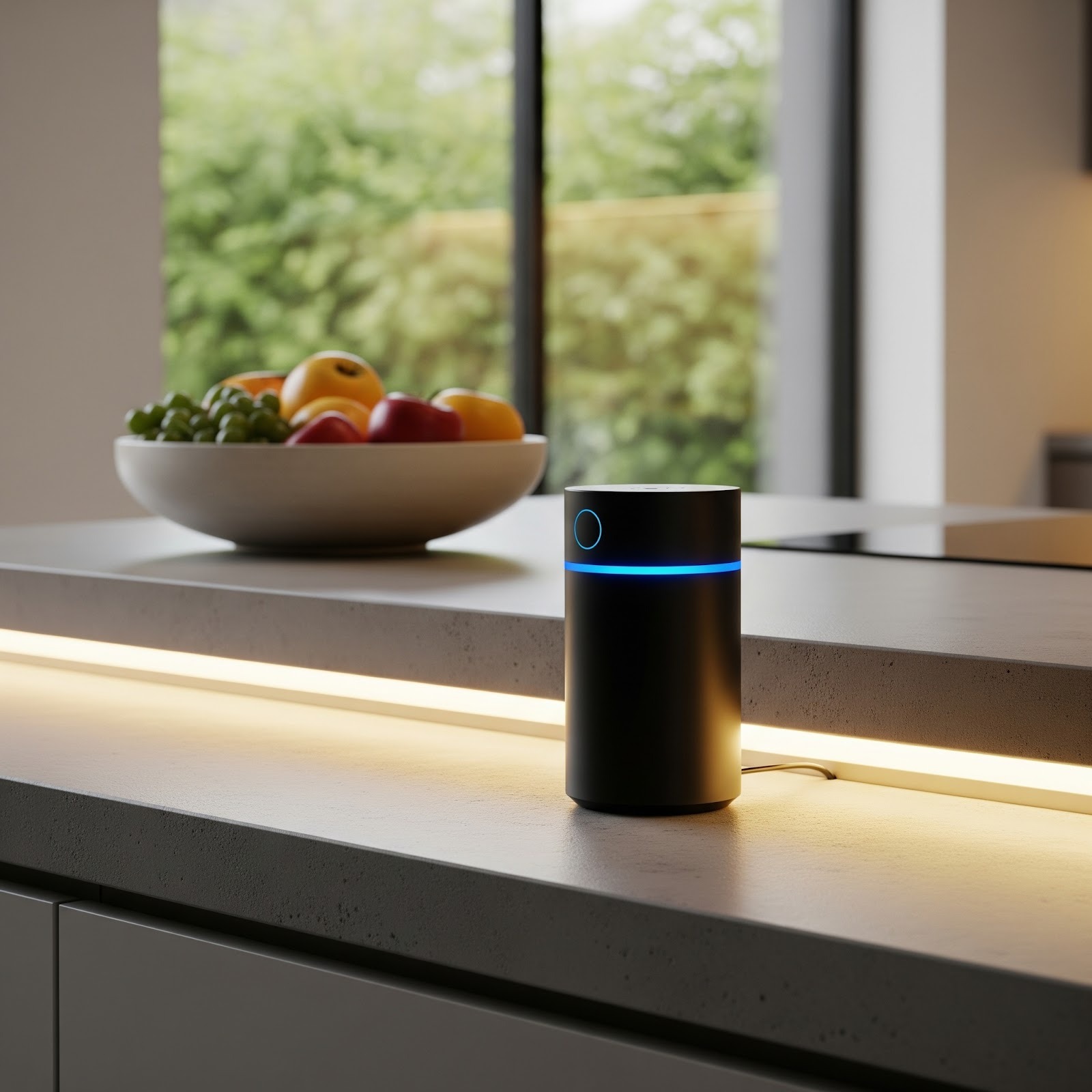What are the best kitchen countertops for your home? The answer depends on your cooking habits, budget, and maintenance preferences. After 22 years of kitchen remodeling experience and over 5,000 completed projects, we’ve helped countless homeowners choose the best countertop materials for their specific needs.
This kitchen countertops guide ranks the top 13 countertop materials based on durability, cost, maintenance, and performance. Whether you’re looking for the best affordable countertops, the most durable kitchen surfaces, or luxury countertop options, this expert comparison will help you make the right choice for your kitchen renovation.
Ranking the Best Kitchen Countertops

1. Quartz Countertops (Engineered Stone)
Made from roughly 90% ground quartz mixed with resins and pigments, engineered quartz combines natural stone beauty with enhanced performance. You’ll find exceptional durability here thanks to the non-porous surface, which never needs sealing and naturally resists stains, scratches, and bacteria. The manufacturing process creates consistent patterns throughout each slab, so achieving a uniform look across your entire kitchen is straightforward.
Watch out for excessive heat, though. High temperatures can damage the resin binders. Large installations may also show visible seams where slabs meet. Busy families love quartz for its low maintenance, and it’s perfect if you want natural stone aesthetics without the upkeep.
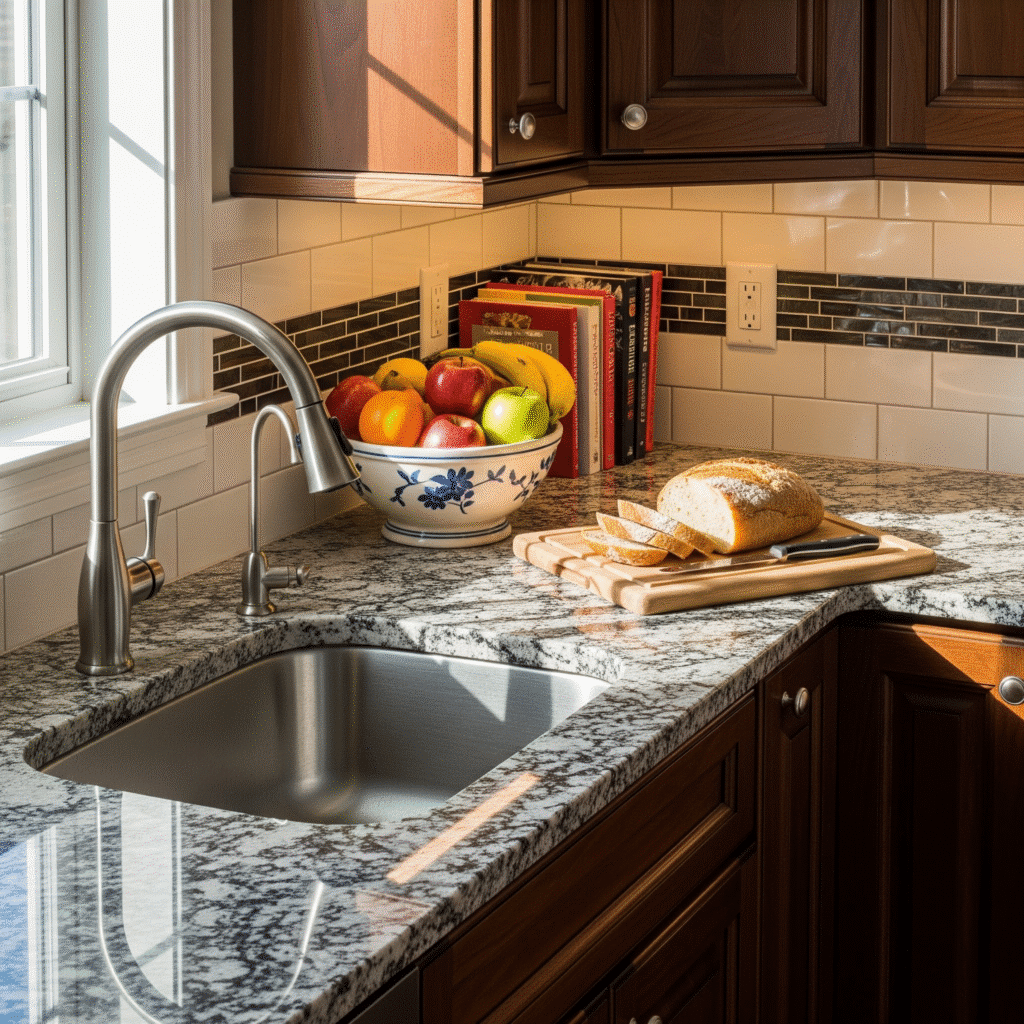
2. Granite Countertops
Each granite slab brings truly one-of-a-kind beauty to your kitchen, with unique patterns that form deep within the earth. The heat resistance is outstanding. You can place hot pans directly on the surface without worry, which appeals to serious home cooks. Traditional kitchens shine with granite’s timeless look, and it typically provides a solid return on investment.
You’ll need to seal granite about once a year to maintain its resistance to stains and moisture. Hard impacts can cause chips, and you might notice natural imperfections in some slabs. Despite these quirks, granite remains a top choice when heat resistance matters most.
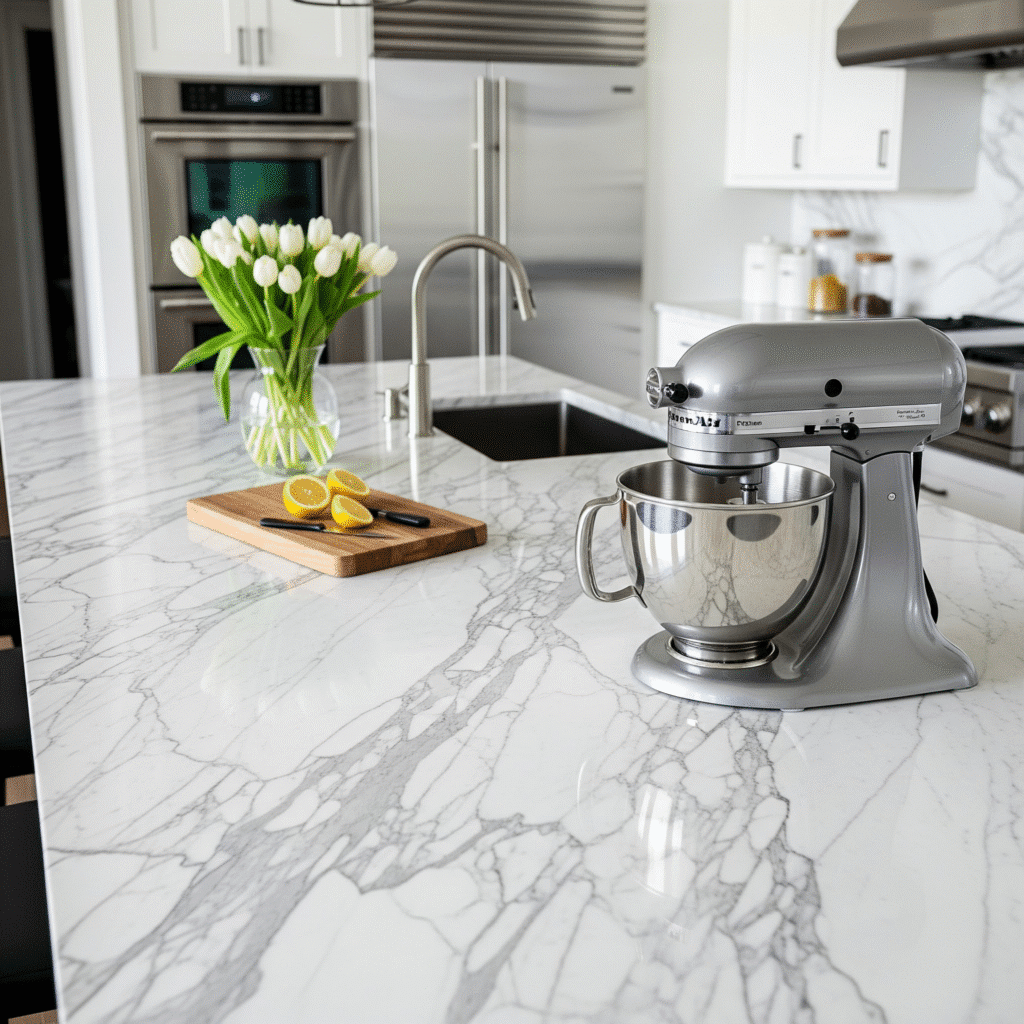
3. Marble Countertops
Marble has been a status symbol for centuries, and it’s easy to see why. The distinctive veining creates sophisticated patterns that no two slabs share. Bakers particularly value how the stone stays naturally cool, perfect for working with temperature-sensitive doughs and pastries. Your home value will likely increase with marble countertops.
But marble demands respect. Lemon juice, wine, and vinegar can all etch the calcium carbonate surface. Scratches happen more easily than with harder stones, and regular sealing is non-negotiable. Think carefully about your cooking habits. If you’re drawn to elegance and mainly do light cooking, marble could be your dream surface. Serious home cooks might find the maintenance frustrating.
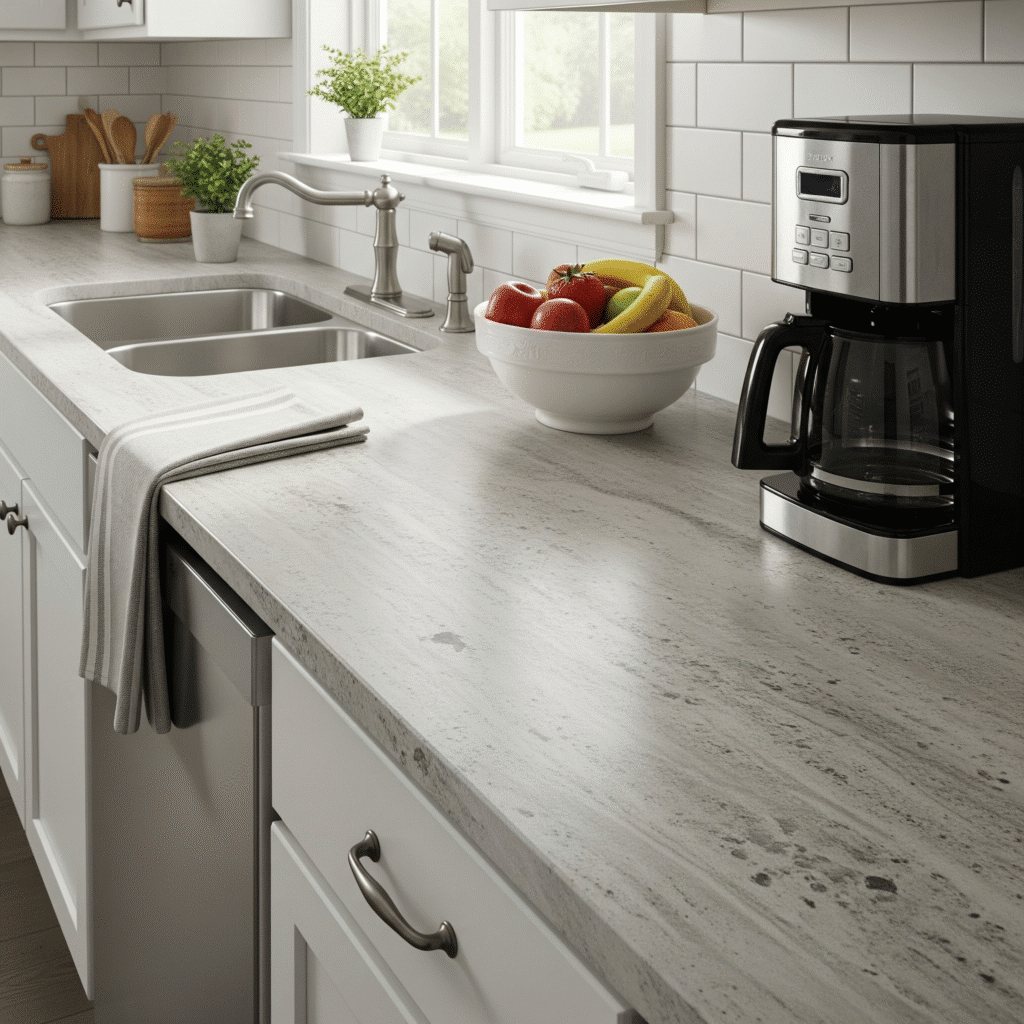
4. Laminate Countertops
Don’t dismiss laminate based on outdated stereotypes. Modern options convincingly mimic premium materials at a fraction of the cost, with hundreds of patterns available. Basic soap and water keep them clean, and DIY-friendly installation saves even more money. When it’s time for a change, replacement is quick and affordable.
Hot pans will burn laminate, so trivets are mandatory. Seams show where sections meet, and damage typically means full replacement since repairs rarely work well. Styles that look current today might feel dated in ten years. Budget-conscious homeowners, landlords managing rental properties, and anyone planning temporary installations get the most value from laminate.
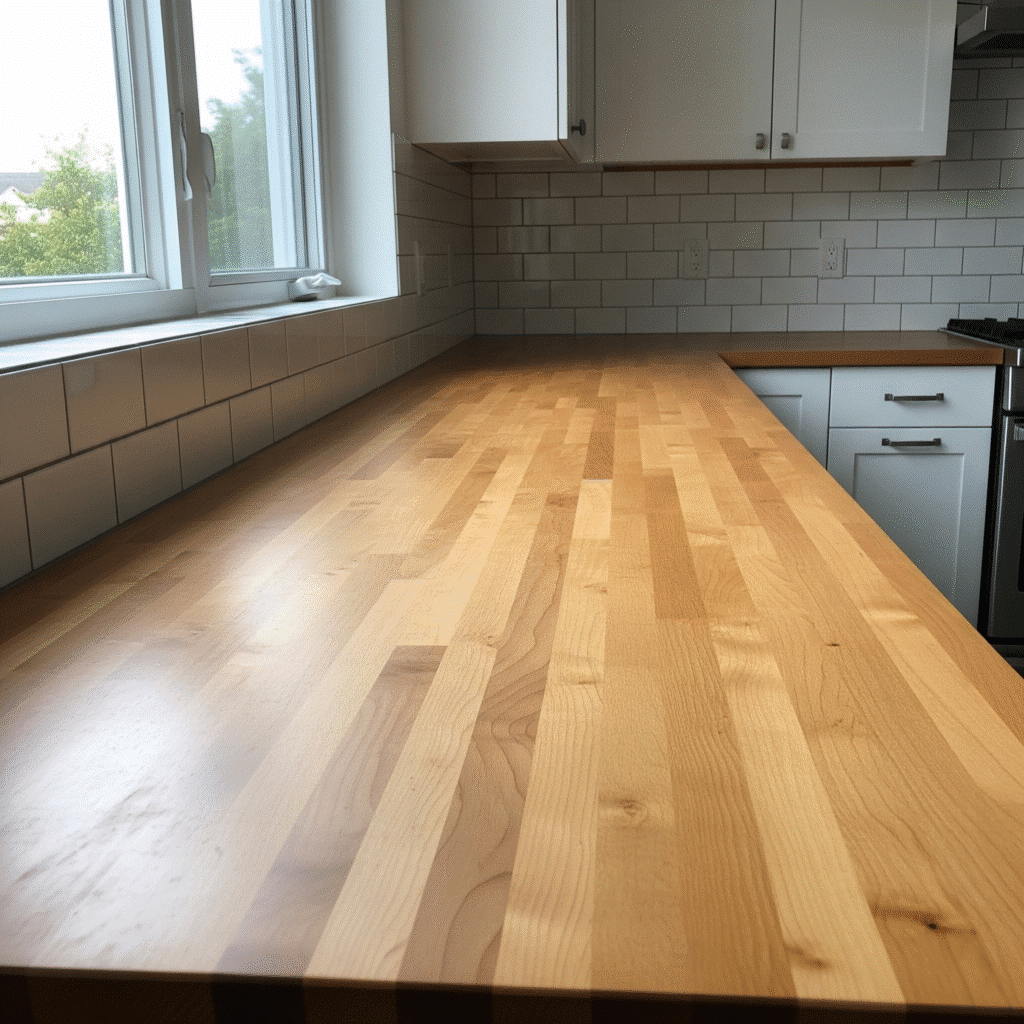
5. Wood / Butcher Block Countertops
Natural wood creates warmth that synthetic materials simply cannot match. The inviting atmosphere works beautifully in farmhouse-style kitchens. Here’s the real advantage: you can sand away scratches and wear patterns, then refinish the surface multiple times over the years. Properly oiled wood even has natural antimicrobial properties.
Regular maintenance is the trade-off. You’ll need to oil or seal the wood consistently to prevent moisture damage. Water and heat can wreak havoc on improperly sealed surfaces, and neglected wood harbors bacteria in scratches. DIY enthusiasts often enjoy this hands-on relationship with their countertops, while others find it burdensome.
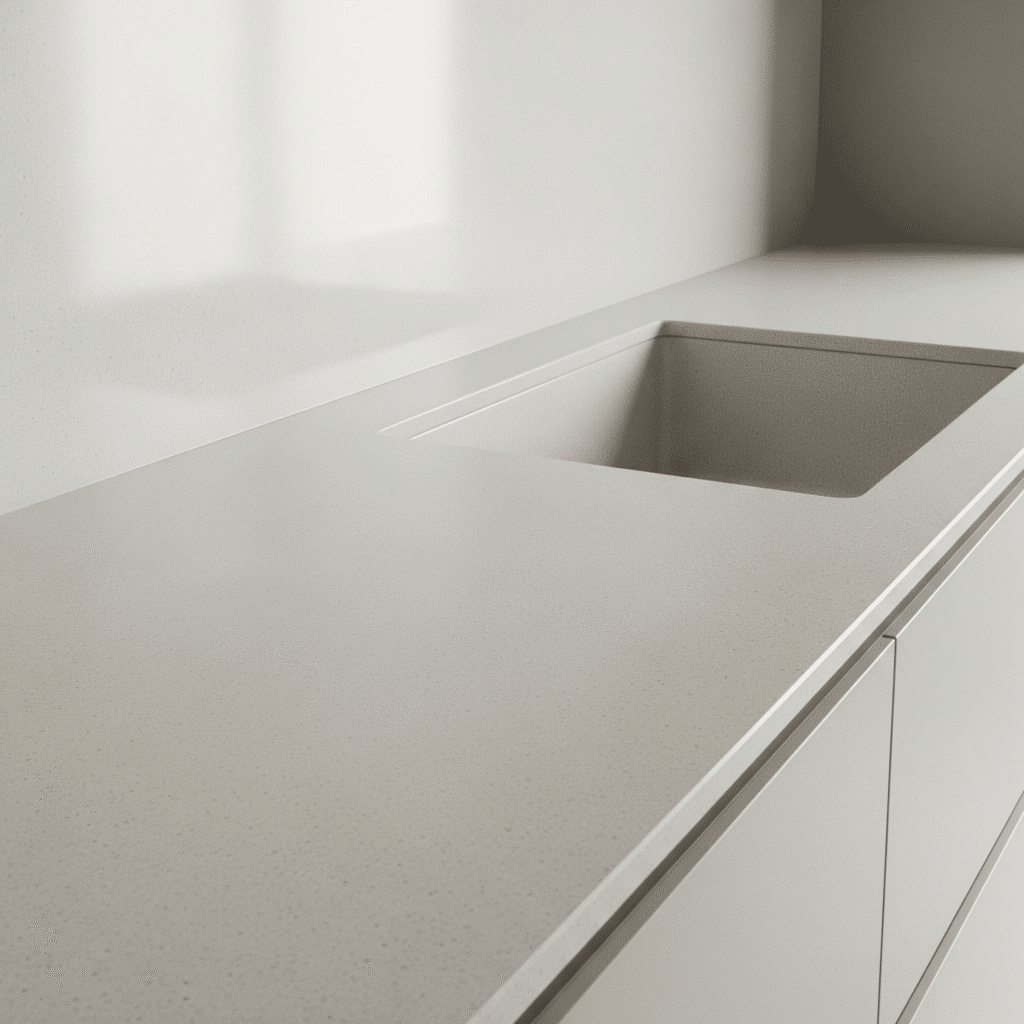
6. Solid Surface Countertops (Corian)
The uniform composition throughout the material allows fabricators to create installations without visible seams. Scratches and minor damage often disappear completely with sanding and buffing. Stains don’t penetrate the non-porous surface, and you can integrate backsplashes and sinks that flow seamlessly from the countertop.
Sharp knives leave marks more easily than on stone, and hot pans cause discoloration. Modern kitchens with clean lines showcase solid surfaces well, especially when seamless appearance tops your priority list. The repairability factor means you won’t necessarily replace damaged sections.
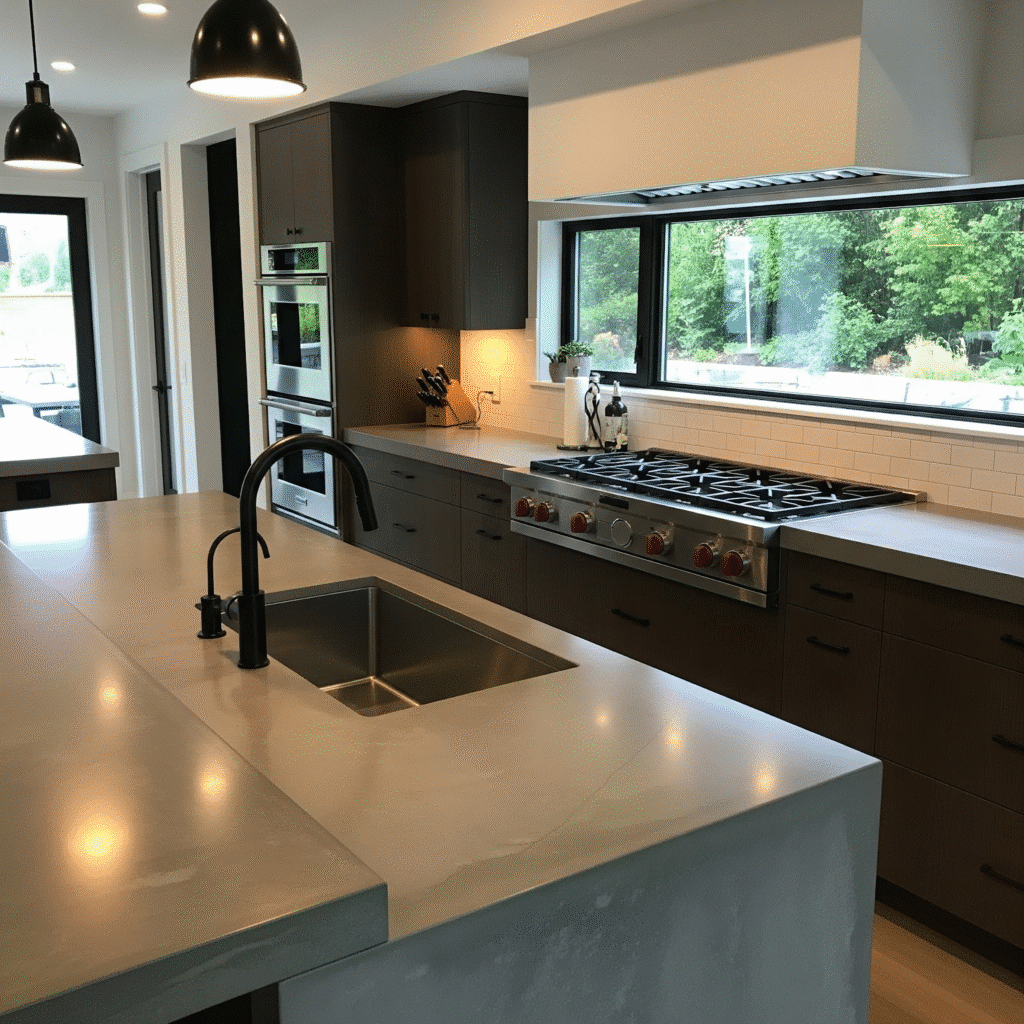
7. Concrete Countertops
Want something truly unique? Concrete offers unlimited customization through colors, textures, and embedded decorative elements. Once cured, it handles heat well. Artists and designers love the creative freedom since each installation becomes one-of-a-kind.
Small cracks develop over time as the material settles and responds to temperature changes. That’s just concrete’s nature. Regular sealing prevents staining and moisture penetration, but you’ll need substantial cabinet support for the weight. Factor in the extended curing timeline, too. Industrial-style kitchens and homeowners seeking artistic expression find these trade-offs worthwhile.
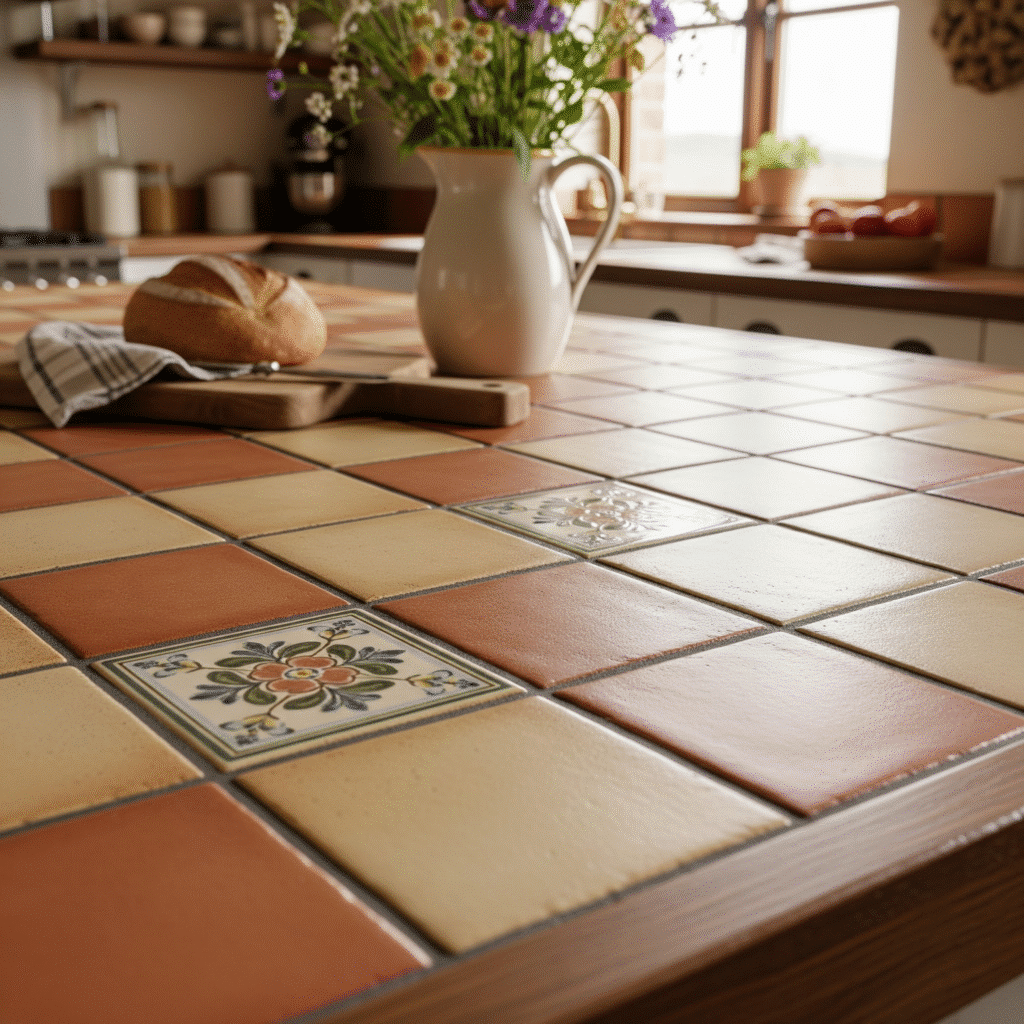
8. Ceramic and Porcelain Tile Countertops
Tile opens up countless design possibilities through color combinations and patterns while staying relatively budget-friendly. Heat and stains don’t faze it, and many homeowners tackle installation themselves. Damaged individual tiles can be swapped out without disturbing the entire surface.
Grout lines create an uneven work surface and need ongoing maintenance to prevent staining. Tiles chip if you drop something heavy, though proper installation minimizes this risk. DIY-inclined homeowners who need heat resistance on a budget often choose tile, accepting the maintenance requirements for the design flexibility.
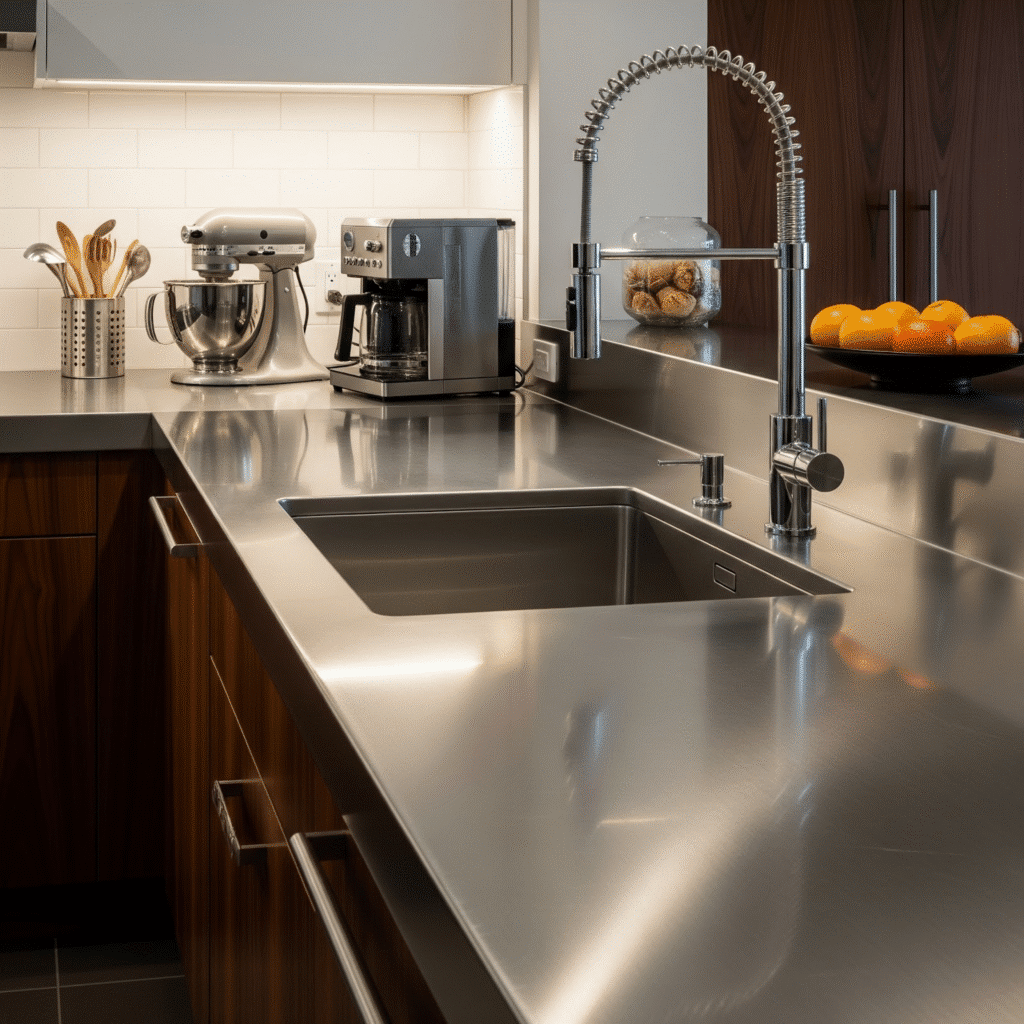
9. Stainless Steel Countertops
Professional kitchens use stainless steel for good reason. The heat resistance is exceptional, and hygiene is unmatched since bacteria can’t penetrate the surface. Integrated sinks create sleek, seamless installations. At the end of life, the material recycles completely.
Water spots and fingerprints show readily on the reflective surface, requiring frequent wiping. Dents and scratches accumulate more easily than on stone. The industrial look isn’t for everyone. Serious home cooks who prioritize function over form, or anyone building a modern industrial-style kitchen, typically overlook these drawbacks.
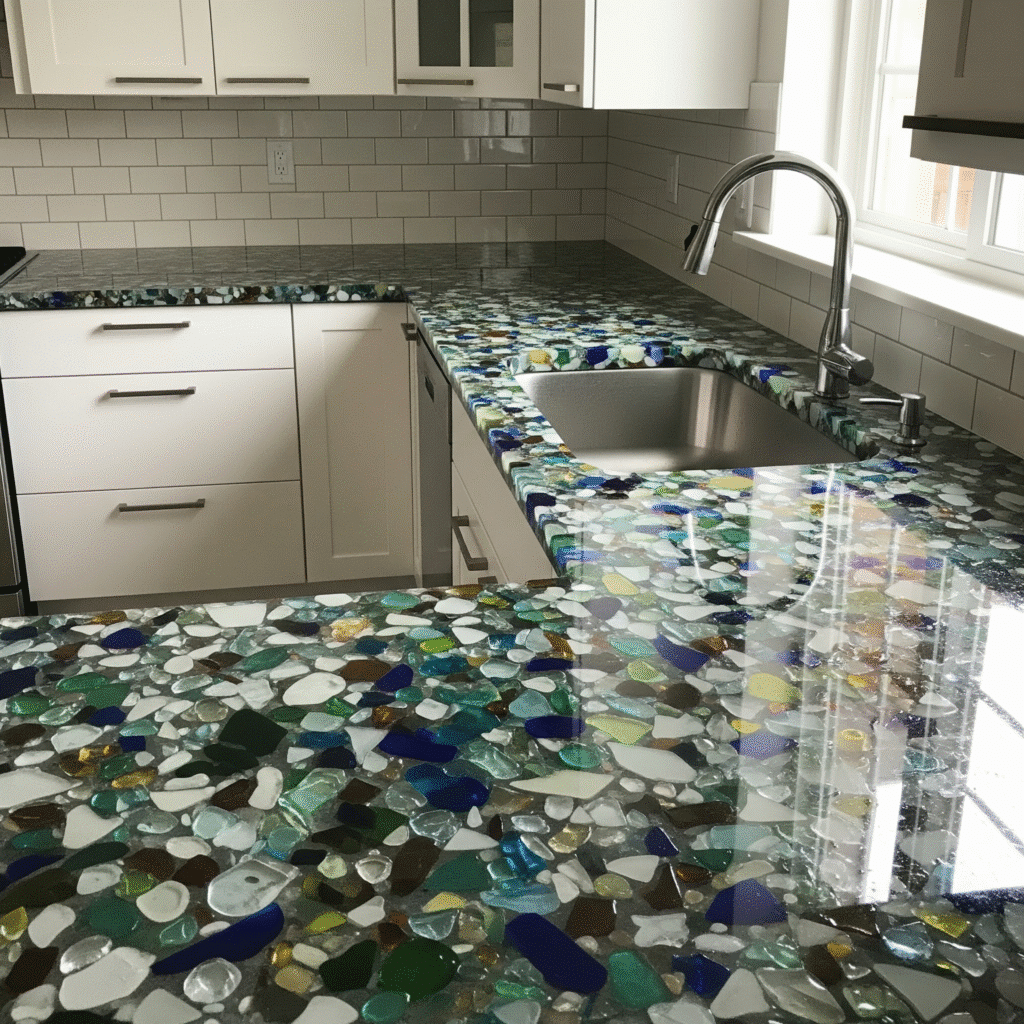
10. Recycled Glass Countertops
These countertops contain 75-85% recycled content, creating sparkling aesthetics unlike anything else while supporting environmental goals. The non-porous surface handles heat and stains well. Glass particles embedded throughout create distinctive patterns.
Availability is limited in many markets, and hard impacts can chip the surface. Repairs prove difficult when damage occurs. Eco-conscious homeowners building sustainable projects often accept these limitations for the unique look and environmental benefits.
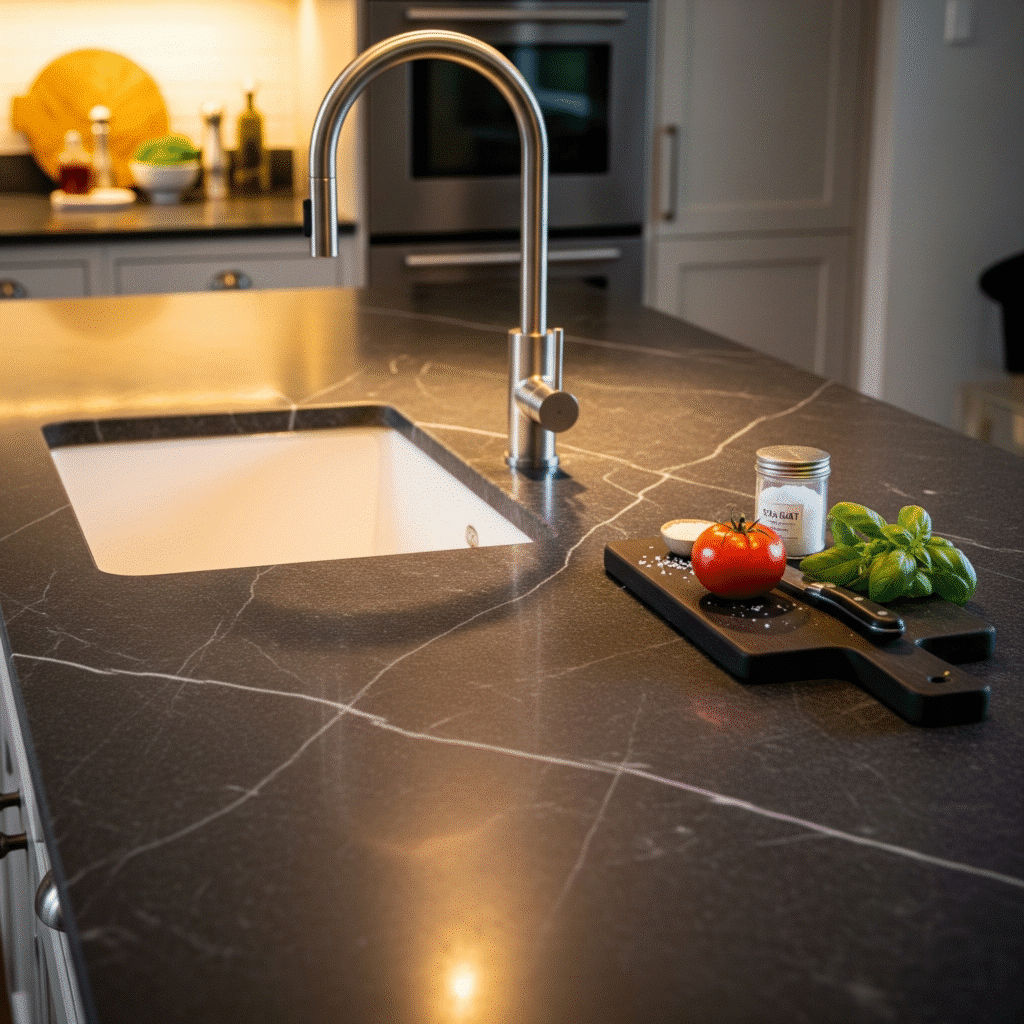
11. Soapstone Countertops
Old-world charm meets practical benefits with soapstone’s naturally non-porous composition. You’ll never seal it, yet it resists stains beautifully. Heat doesn’t damage it, and the patina that develops over time adds character. Scratches? Rub in some mineral oil and they disappear. Chemicals that would ruin other natural stones don’t affect soapstone.
Gray tones dominate your color palette with soapstone, though natural variation provides interest. The soft stone scratches more readily than granite or quartz, even if those marks are easily fixed. Periodic mineral oil treatments maintain appearance and deepen the color. The unique matte finish sets soapstone apart from polished alternatives, which appeals to certain aesthetic sensibilities.

12. Quartzite Countertops
Think of quartzite as marble’s tougher sibling. You get elegant veining patterns with durability approaching granite’s legendary hardness. Heat and scratches barely affect it, and unlike many stones, UV exposure won’t cause fading. Annual sealing provides adequate protection without marble’s intensive maintenance.
Acidic substances can still etch the surface, similar to marble. Limited quarrying locations mean less availability than common stones like granite. Sun-exposed installations benefit from the UV resistance, and anyone wanting marble’s beauty with better performance should consider quartzite seriously.
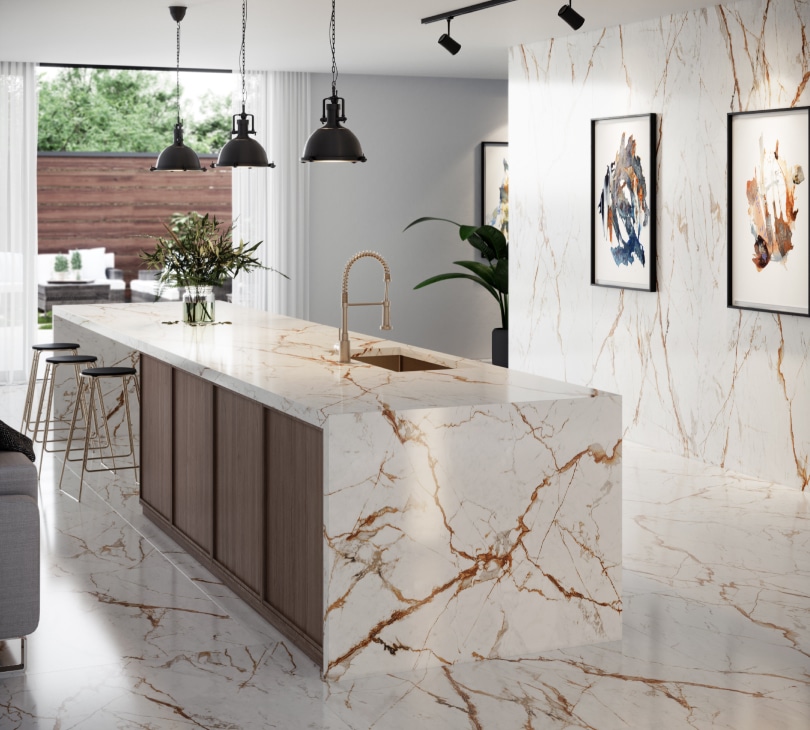
13. Dekton and Ultra-Compact Surfaces
This represents the cutting edge in engineered stone technology. Durability and scratch resistance exceed traditional materials significantly. High heat doesn’t faze it, UV exposure causes no damage, and stains and chemicals make barely any impact. Large slabs minimize seams in expansive kitchens, and the performance in outdoor applications surpasses other surfaces.
Finding it can be challenging in some markets, and you’ll need fabricators experienced with its unique properties. Edges can chip despite overall toughness. Outdoor kitchen installations particularly benefit from the weather resistance, and anyone wanting maximum performance from latest technology will appreciate what ultra-compact surfaces deliver.
Kitchen Countertops Comparison Chart
| Countertop Material | Durability | Maintenance | Heat Resistance | Best Kitchen Application |
|---|---|---|---|---|
| Quartz | Excellent | Very Low | Good | Busy families, low maintenance kitchens |
| Granite | Excellent | Low | Excellent | Serious cooks, traditional kitchen style |
| Marble | Good | High | Good | Luxury aesthetic, light cooking |
| Quartzite | Excellent | Low | Excellent | Luxury with durability |
| Laminate | Fair | Low | Poor | Budget projects, temporary solutions |
| Solid Surface | Good | Very Low | Fair | Seamless appearance priority |
| Wood Block | Fair | High | Poor | Natural warmth, farmhouse style |
| Concrete | Good | Medium | Good | Custom design, industrial style |
| Tile | Good | Medium | Good | Design flexibility, DIY option |
| Stainless Steel | Excellent | Low | Excellent | Professional kitchens |
| Recycled Glass | Good | Low | Good | Eco-friendly, unique sparkle |
| Soapstone | Good | Medium | Excellent | Old-world charm, heat resistance |
| Ultra-Compact | Excellent | Very Low | Excellent | Latest technology, max performance |
Choosing The Right Kitchen Countertops Option
Answer these questions to help decide what is the best countertop material for you.
Budget Range for Kitchen Countertops:
- Budget-conscious countertops: Laminate, ceramic tile
- Mid-range kitchen countertops: Quartz, granite, solid surface
- Premium luxury countertops: Marble, quartzite, natural stone
Maintenance Preference:
- Low maintenance: Quartz, solid surface
- Moderate maintenance: Granite (annual sealing)
- High maintenance: Marble, wood (frequent sealing/oiling)
Kitchen Usage and Cooking Habits:
- Heavy cooking/baking: Heat-resistant materials (granite, quartzite)
- Families with children: Non-porous surfaces (quartz, solid surface)
- Light cooking: Most materials work well
Read our entire guide on remodeling your kitchen or learn about kitchen remodel financing
Food Safety and Durability Factors
Hygiene and Food Safety in Kitchen Countertops
Non-Porous Countertops (Best for Food Safety):
- Quartz countertops: Engineered to be completely non-porous with no bacterial entry points
- Solid surface countertops: Seamless installation prevents bacteria harboring in joints
- Stainless steel: Hospital-grade hygiene with complete bacterial resistance
Porous Kitchen Countertops (Require More Care):
- Granite: Natural porosity varies; requires annual sealing
- Marble: Highly porous; needs frequent sealing and immediate spill cleanup
- Wood: Can harbor bacteria in scratches without proper maintenance
Heat and Scratch Resistance Rankings
Heat Resistance for Kitchen Countertops:
- Granite/Quartzite: Handle hot cookware directly (500°F+)
- Quartz: Good resistance but avoid hot pots (300°F limit)
- Marble/Laminate: Require protection from heat
Scratch Resistance Rankings:
- Quartzite (hardest natural stone)
- Granite
- Quartz
- Solid surface (repairable)
- Marble/Wood/Laminate (easily damaged)
Choose Artistic Construction for Your Kitchen Renovation
With over 22 years of kitchen remodeling experience and 5,000+ completed projects, we’ve guided countless homeowners to the perfect countertop choice for their lifestyle and budget.
Ready to discover which kitchen countertop material is truly the best choice for your home? Contact Artistic Construction for a consultation where we’ll assess your cooking habits, lifestyle, and budget to recommend the ideal solution from our expert-ranked countertop options.
Serving homeowners throughout the greater Atlanta area with expert kitchen countertop guidance and stress-free installations since 2002.
Frequently Asked Questions About Kitchen Countertops
What’s the best material to use for kitchen countertops?
There isn’t one single “best” material for every kitchen, as the ideal choice depends on your budget, lifestyle, and design preferences. However, engineered quartz is often cited as the top contender for its excellent balance of durability, low maintenance, and aesthetic versatility. Other popular high-performing materials include granite, celebrated for its natural beauty and heat resistance, and quartzite, which offers the look of marble with superior durability. For those on a tighter budget, modern laminate countertops offer a wide array of styles at a fraction of the cost.
Is quartz better or granite?
The debate between quartz and granite is common, as both are excellent choices. Quartz is an engineered product made from crushed natural quartz and resin, making it non-porous. This means it never needs to be sealed and is highly resistant to stains and bacteria. Granite is a 100% natural stone, so each slab is unique. It is highly resistant to heat but is porous and must be sealed periodically (usually once a year) to prevent staining. Ultimately, quartz is better for those seeking zero maintenance and consistent patterns, while granite is ideal for those who want a one-of-a-kind, natural stone surface and don’t mind minimal upkeep.
What is the easiest kitchen countertop to maintain?
Quartz is widely considered the easiest kitchen countertop to maintain. Because it is an engineered, non-porous material, it does not require any sealing. Spills are simple to clean up with soap and water and will not penetrate the surface to cause stains. Its durability also makes it highly resistant to scratches and chips, ensuring it looks great for years with minimal effort.
What is the most popular kitchen countertop right now?
As of 2025, engineered quartz continues to be the most popular kitchen countertop material. Homeowners and designers favor it for its vast selection of colors and patterns, from realistic marble looks to modern concrete styles. Its superior durability and maintenance-free qualities are perfectly suited for the demands of a busy modern kitchen, making it the top choice in today’s market. Natural stones with subtle, warm tones and soft veining, like certain quartzites and marbles, are also trending.
What countertops never go out of style?
Countertops that offer a timeless, classic look tend to be those made from natural stone or materials that mimic it. Marble, particularly Carrara or Calacatta, has a classic elegance that has endured for centuries. Similarly, the natural, earthy appeal of many granite slabs in neutral tones remains a classic choice. For an engineered option, a simple white or soft gray quartz that mimics the look of natural marble is a safe bet for a look that will remain stylish for decades to come.
Can you put hot pans on granite?
Yes, you can generally place hot pots and pans directly on a granite countertop without damaging it. Granite is an igneous rock formed under immense heat and pressure, making it very resistant to high temperatures. However, while the stone itself can handle the heat, repeated exposure to extreme temperature changes (known as thermal shock) could potentially cause a crack, especially if there’s a pre-existing flaw in the stone. For this reason, experts still recommend using a trivet or hot pad as a precaution to ensure the longevity of your countertop.
